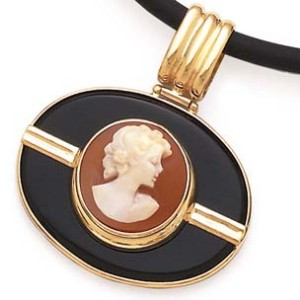 This month’s gemstone is Sardonyx, the alternative birthstone for August (photograph at left from Thaigem). The modern birthstone is peridot (covered in a previous article) but sardonyx has an ancient history and is a fascinating stone.
This month’s gemstone is Sardonyx, the alternative birthstone for August (photograph at left from Thaigem). The modern birthstone is peridot (covered in a previous article) but sardonyx has an ancient history and is a fascinating stone.
Gemmology Matters: Sardonyx is a variety of onyx which is a form of banded chalcedony (cryptocrystalline quartz or SiO2) or agate. The name sardonyx derives from the word “sard” and “onyx” relating to the striped or banded appearance of layers of white, grey or black interspersed with reddish brown. As a variety of quartz, sardonyx has a hardness of 7 and is reasonably strong although prone to chips and scratches. The durability of sardonyx, combined with its attractive coloured pattern means that it is frequently used for beads and brooches.
Sardonyx has been mined in India for thousands of years and it remains a major source of this ancient gemstone. Other locations include Russia, Pakistan, USA, Germany, Brazil, Mexico, Czechoslovakia and Africa. Sardonyx is a relatively inexpensive stone and may be found in large sizes. Stones with bright orange-red, reddish brown and white bands are popular. Natural sardonyx is rarely found commercially with enhancement treatments common – usually dying or staining to intensify or alter colour.
Mythology and Lore: According to Pliny, sard is named after Sardis where that mineral is found. Onyx is named after the Greek word for “nail” because its veined appearance resembles a fingernail. Sardonyx was highly valued in Rome, especially for seals, because it was said to never stick to the wax.
The ancient Greeks and Romans were very fond of sardonyx and believed it could bring courage and victory. Sardonyx was often engraved with images of relevant gods (such as Ares, Hercules or Mars) and carried into battle by soldiers who believed they would become as brave as the figures carved on these talismans. Away from the battlefield it was believed to lend the gift of persuasiveness to orators and leaders.
 Sardonyx cameos were very popular in Roman times. The example at left depicting the coronation of Constantin the Great is from the “Road to Byzantium exhibition” by the Hermitage Rooms. See the Vroma website for more images of these ancient pieces in cameo work. Sardonyx has been used for this type of jewellery for centuries where the different bands of colour carved in relief highlight the image against the background.
Sardonyx cameos were very popular in Roman times. The example at left depicting the coronation of Constantin the Great is from the “Road to Byzantium exhibition” by the Hermitage Rooms. See the Vroma website for more images of these ancient pieces in cameo work. Sardonyx has been used for this type of jewellery for centuries where the different bands of colour carved in relief highlight the image against the background.
 The popularity of sardonyx for cameo jewellery lasted well into modern times although the designs still tend to draw from ancient themes. The piece on the right has a more contemporary “feel” about it although the carved design is still quite traditional in style.
The popularity of sardonyx for cameo jewellery lasted well into modern times although the designs still tend to draw from ancient themes. The piece on the right has a more contemporary “feel” about it although the carved design is still quite traditional in style.
Sardonyx is said to calm the mind, aid communication and promote happiness in marriage and relationships. An old rhyme listing birthstones and their associated traits claims that:
The August maiden, with sweet simplicity
wears Sardonyx, gem of felicity.
Alternative Stones: Within the agate family, there is a huge variety of form and pattern. Many varieties exist and are named for origin, colour or pattern. Sardonyx and other agate varieties possess a unique beauty that cannot be matched by any other gemstone. There is no real alternative to this gem. The affordability of sardonyx means that anyone can add a piece to their collection.
Sources and Links of Interest:
Article on Sardonyx by Thaigem.com
ICGA Gem by Gem article on Onyx
Signets, Amulets and Jewelry Gemstone Engravings Over the Passage of Time (article by Peter Henselder on Ganoskin)
Add More Color To Your Life article on Chalcedony
Mineral and Gemstone Kingdom – article on Chalcedony
Hope you enjoyed this month’s article.
That is all for now from Aussie Sapphire
